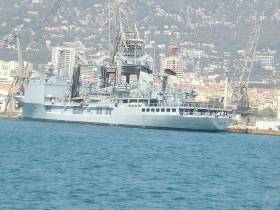Displaying items by tag: French Embassy
Flotilla From French Navy All to Arrive to Dublin Port This Friday
#FrenchFriday- A flotilla from the French Navy are all scheduled to have arrived to Dublin Port this Friday and in the capital the French embassy will on Saturday take part in 'Open House Dublin' this weekend, writes Jehan Ashmore.
Originally a quartet of French naval vessels were expected to call, however Afloat has monitored that this total has been reduced to three ships that are to visit. They are a minehunter, a frigate and an auxiliary oil/stores replenishment ship.
First to arrive at lunch hour today, will be the minehunter Sagittaire of the 'Eridan' class also otherwise known as the 'Tripartite' class. They are from a shared ship build programme that was co-ordinated with the combined co-operation of the French, Belgium and Dutch navies.
The 51m Sagittaire with a displacement of 615 tonnes is to arrive upriver along Sir John Rogersons Quay. This 21 year old vessel was completed by Direction des Constructions Navales (DCN) in Lorient, south Brittany.
The remaining pair are to arrive tomorrow, firstly in the form of the frigate Lieutenant de vaisseau Lavallée. This 80m vessel which is a 'Estienne d'Orves' class OPV frigate that among its principle weaponary consists of Exocet missiles. Likewise of the minehunter, the frigate will take a berth upriver on the Liffey along Sir John Rogersons Quay.
This leaves the final caller the 157m BCR Somme, the second of three 'Durance' class oil /stores supply sisters in which this particular ship entered service in 1990. The 18,000 full displacment tonnes ship is to dock within the deeper waters of Alexandra Basin. This is the largest basin within the port that is located close to the Tom Clarke bridge.
As previously reported here on Afloat, it is at the Tom Clarke bridge (seaward side) where the excursion boat St. Bridget will be operating (pre-booked) port tours (Saturday, 14 Oct) also as part of events during Open House Dublin. The tour is to take in Alexandra Basin where phase one of major redevelopment works has begun as part of the port masterplan.





























































